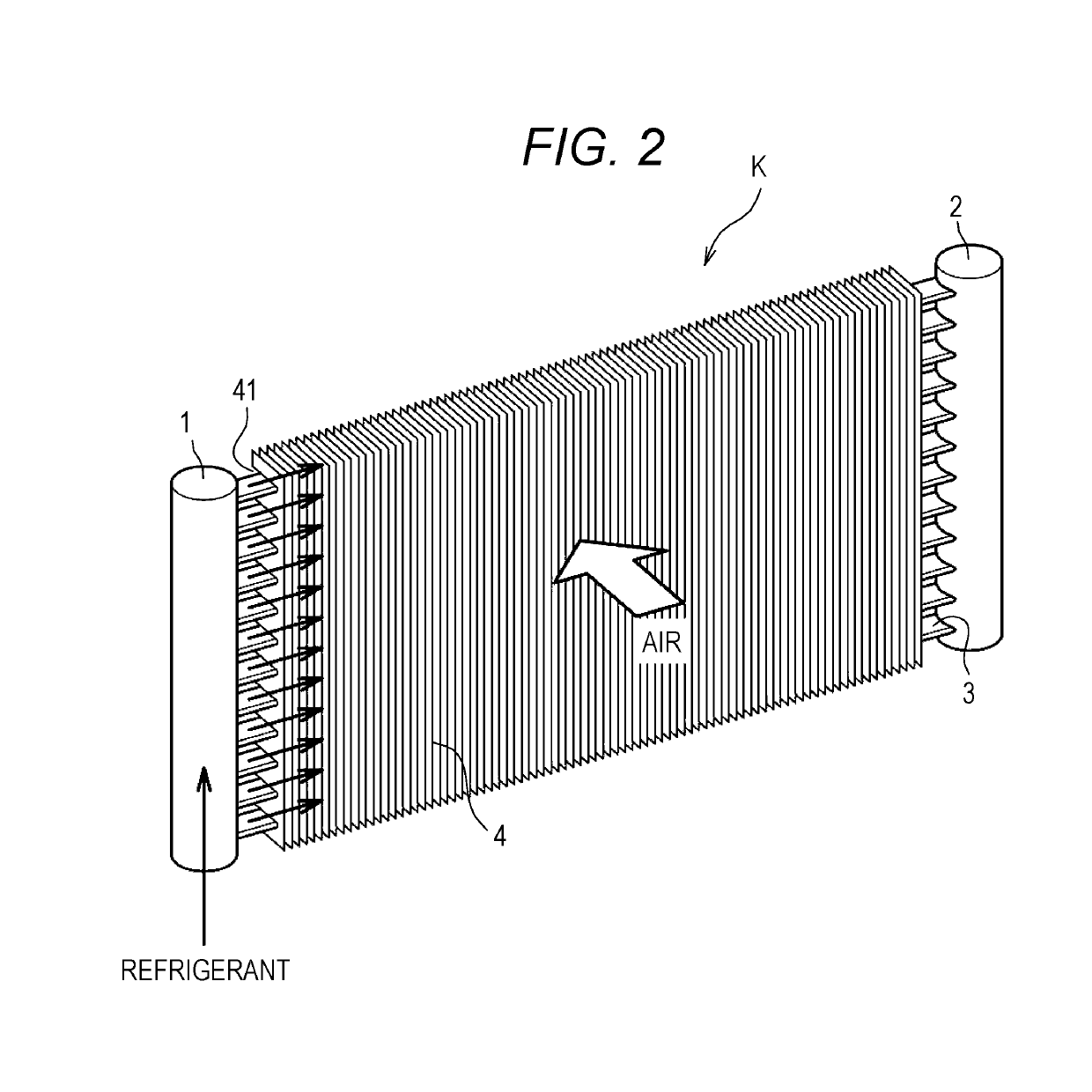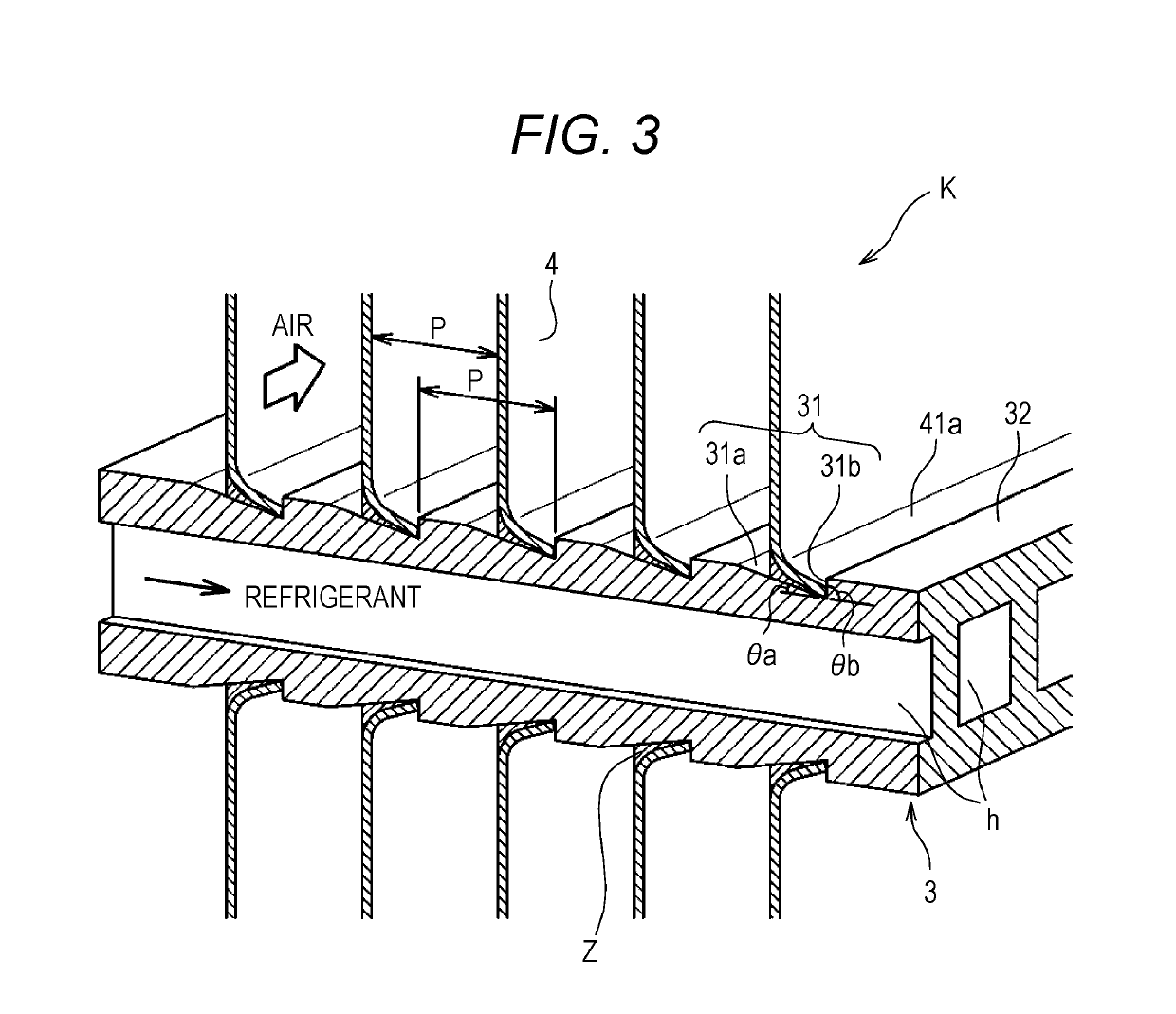Heat exchanger and air-conditioner
a technology of heat exchanger and air conditioner, which is applied in the direction of indirect heat exchanger, light and heating apparatus, refrigeration components, etc., can solve the problems of affecting the operation of the heat exchanger, so as to achieve the effect of convenient setting
- Summary
- Abstract
- Description
- Claims
- Application Information
AI Technical Summary
Benefits of technology
Problems solved by technology
Method used
Image
Examples
first embodiment
[0022]FIG. 1 is a configuration diagram of a refrigerant circuit Q of an air-conditioner W. Note that solid arrows of FIG. 1 indicate a refrigerant flow in cooling operation. On the other hand, dashed arrows of FIG. 1 indicate a refrigerant flow in heating operation. The air-conditioner W is equipment configured to perform air-conditioning in such a manner that refrigerant circulates in a refrigeration cycle (a heat pump cycle). As illustrated in FIG. 1, the air-conditioner W includes a compressor 11, an outdoor heat exchanger 12 (a heat exchanger), an outdoor fan 13, an indoor heat exchanger 14 (a heat exchanger), an indoor fan 15, a throttle device 16 (an expansion valve), and a four-way valve 17.
[0023]In an example illustrated in FIG. 1, the compressor 11, the outdoor heat exchanger 12, the outdoor fan 13, the throttle device 16, and the four-way valve 17 are provided at an outdoor unit Wo. On the other hand, the indoor heat exchanger 14 and the indoor fan 15 are provided at an i...
second embodiment
[0056]In a second embodiment, the shape of a cutout 31A of a flat pipe 3A (see FIG. 5) is different from the shape of the cutout 31 of the first embodiment. Moreover, the second embodiment is different from the first embodiment in that an opening distance L of an opening 41 (see FIG. 5) is relatively long and each fin collar 41a is pressed against a first inclined surface 31a. Note that other configurations are similar to those of the first embodiment. Thus, the configurations different from those of the first embodiment will be described below. Overlapping configuration description will be omitted.
[0057]FIG. 5 is a partially-enlarged perspective view in a state before each fin collar 41a contacts the cutout 31A, the partially-enlarged perspective view including a longitudinal section of a heat exchanger KA according to the second embodiment. That is, in FIG. 5, fins 4A are not brazed in the middle of assembly with the flat pipe 3A. As in the first embodiment, the multiple linear cu...
third embodiment
[0064]A third embodiment is different from the first embodiment in that each cutout 31B formed at a flat pipe 3B (see FIG. 7) is curved as viewed in a longitudinal section and each fin collar 41Ba is also curved accordingly as viewed in the longitudinal section. Note that other configurations are similar to those of the first embodiment. Thus, the configurations different from those of the first embodiment will be described below. Overlapping configuration description will be omitted.
[0065]FIG. 7 is a partially-enlarged perspective view including a longitudinal section of a heat exchanger KB according to the third embodiment. As illustrated in FIG. 7, the multiple linear cutouts 31B are formed at predetermined intervals each equal to fin pitches P on both of upper and lower sides of the flat pipe 3B in a flat shape as viewed in the longitudinal section.
[0066]Each of the multiple cutouts 31B is in a curved shape as viewed in the longitudinal section. On the other hand, each opening 4...
PUM
 Login to View More
Login to View More Abstract
Description
Claims
Application Information
 Login to View More
Login to View More - R&D
- Intellectual Property
- Life Sciences
- Materials
- Tech Scout
- Unparalleled Data Quality
- Higher Quality Content
- 60% Fewer Hallucinations
Browse by: Latest US Patents, China's latest patents, Technical Efficacy Thesaurus, Application Domain, Technology Topic, Popular Technical Reports.
© 2025 PatSnap. All rights reserved.Legal|Privacy policy|Modern Slavery Act Transparency Statement|Sitemap|About US| Contact US: help@patsnap.com



